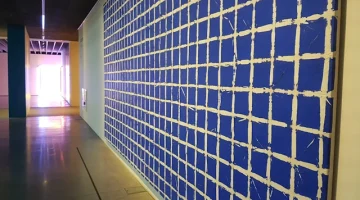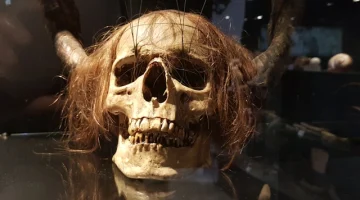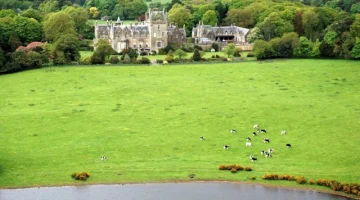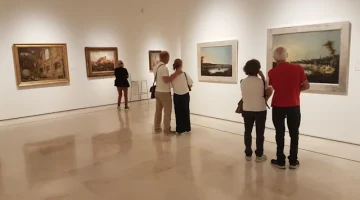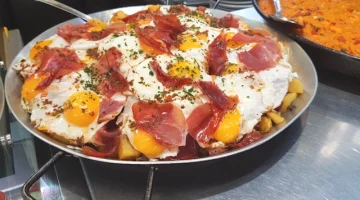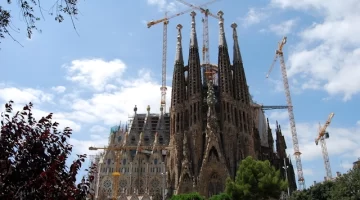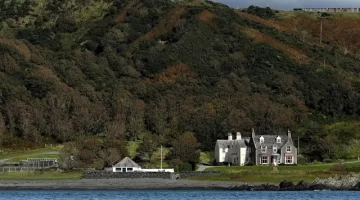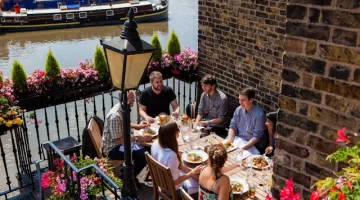Ten Best Things to See in Khiva
The Travel Pages lists ten of the best things to see in the city of Khiva in Uzbekistan including the historic walled city, mosques, minarets and madrasahs.
Khiva is renowned for its well-preserved historic architecture and cultural significance. The Organization of Islamic Cooperation (OIC) has chosen Khiva as the 2024 Tourism Capital of the Islamic World. The city will host a special programme of events throughout the year, making it the perfect time to visit the Ichan Qala UNESCO World Heritage Site and nearby attractions, and to enjoy the culture and hospitality of the Khorezm Region.

Here are ten of the best things to see in Khiva:
Ichan Qala (Itchan Kala): This is the historic walled city of Khiva, and it’s where you’ll find most of the major attractions. Stroll through its narrow streets, admire the intricate architecture, and soak in the atmosphere of what is one of the most significant and well-preserved examples of a medieval Central Asian city. It has a history dating back over 2,000 years, with its roots as a major trading post along the Silk Road. Spanning 26 hectares, this UNESCO World Heritage site is enclosed by imposing mud-brick walls, standing as a testament to Khiva’s rich cultural legacy.

Within its confines lies a labyrinth of narrow streets, adorned with intricately decorated mosques, madrasas, and palaces, showcasing exquisite Islamic architecture. Visitors are transported back in time as they wander through its well-preserved buildings, each bearing tales of conquests, trade, and scholarly pursuits. Ichan Qala stands as a living museum, preserving the essence of Khiva’s illustrious past for generations to come.

Kalta Minor Minaret: The Kalta Minor Minaret, located in the heart of Ichan Qala, is a striking architectural marvel characterized by its unique unfinished appearance and vibrant turquoise tilework. Constructed in the early 19th century by the ruler Muhammad Amin Khan and planned as the tallest minaret in Central Asia, its intended height of 70 meters was never realized due to the khan’s sudden death.
Nevertheless, the minaret stands at around 29 meters, showcasing intricate geometric patterns and floral motifs. Despite its incomplete state, the Kalta Minor Minaret remains an iconic symbol of Khiva, drawing visitors from around the world.
Mohammed Amin Khan Madrasah: One of the largest madrasahs in Khiva, this is a masterpiece of Islamic architecture dating back to the 19th century. Commissioned by the Khan himself, it stands as a testament to the wealth and cultural richness of the Khiva Khanate. The madrasah boasts an intricately adorned facade, adorned with elaborate tilework and colorful mosaics, showcasing geometric patterns and floral motifs typical of Central Asian design. Its courtyard has a peaceful atmosphere and is adorned with carved wooden columns and a central fountain. Today, the Mohammed Amin Khan Madrasah stands as a revered symbol of religious and educational heritage in Khiva.

Kunya-Ark Citadel: This ancient fortress was once the residence of Khiva’s rulers. Climb to the top for panoramic views of the city and learn about its history in the onsite museum. It’s a formidable fortress steeped in history and architectural grandeur. Dating back to the 17th century, it served as the residence of Khivan khans and the seat of their power.
Enclosed within thick walls, the citadel features towering bastions, majestic gateways, and intricately decorated halls. Its inner complex comprises a labyrinth of rooms, including reception chambers, living quarters, and administrative offices, adorned with exquisite tilework and ornate carvings. Today, the Kunya-Ark Citadel stands as a poignant reminder of Khiva’s illustrious past.

Tash-Hauli Palace: The Tash-Hauli Palace, situated within the ancient walls of Ichan Qala, is a stunning architectural gem showcasing the opulence and sophistication of the Khiva Khanate. Built in the 19th century, it served as the summer residence of the Khivan khans, offering resplendent courtyards, intricately adorned rooms, and lush gardens.
The palace’s name, meaning “stone courtyard,” reflects its grandeur and solid construction. Its interior features elaborate woodcarvings, vibrant tilework, and intricate ceiling paintings, depicting scenes from daily life and Islamic motifs. Today, the Tash-Hauli Palace stands as a testament to Khiva’s rich cultural heritage.

Juma Mosque: Known for its 200 wooden columns supporting the roof, this mosque is unique in its design. It’s a masterpiece of Islamic architecture and religious significance. Dating back to the 10th century, it stands as one of the oldest and most sacred mosques in Central Asia.

The mosque’s distinguishing feature is its forest of intricately carved wooden columns, numbering over two hundred, supporting the roof without the need for internal pillars. The prayer hall, adorned with colorful carpets and exquisite tilework, exudes a tranquil atmosphere conducive to spiritual reflection.
Pahlavan Mahmud Mausoleum: This mausoleum honors the revered poet, wrestler, and patron saint Pahlavan Mahmud. Constructed in the 14th century and expanded over subsequent centuries, it stands as a testament to the blend of spiritual devotion and martial prowess characteristic of Khivan culture.

The mausoleum’s majestic turquoise dome and intricate tilework reflect the architectural splendor of the Timurid era. Inside, the tomb of Pahlavan Mahmud is adorned with richly embroidered textiles and delicate plasterwork, creating a serene atmosphere for visitors and pilgrims alike. The mausoleum remains a cherished pilgrimage site, embodying the enduring legacy of a legendary figure in Khiva’s history.
Islam Khodja Minaret and Madrasah: The Islam Khodja Minaret and Madrasah is an architectural marvel dating back to the early 20th century. The minaret, towering at over 57 meters, stands as one of the tallest in Central Asia, adorned with intricate brickwork and turquoise tile embellishments. Adjacent to the minaret, the madrasah showcases exquisite Islamic architecture, featuring a grand entrance portal and ornate facade. Inside, the madrasah’s courtyard boasts a tranquil setting, with intricately carved wooden columns and colourful mosaic patterns. The Islam Khodja complex stands as a testament to Khiva’s cultural heritage and architectural prowess.

Allakuli Khan Caravanserai: The Allakuli Khan Caravanserai, situated in the heart of Ichan Qala, is a testament to Khiva’s rich history as a bustling hub along the Silk Road. Built in the 19th century during the reign of Allakuli Khan, it served as a vital stopover for traders and travelers journeying through the region.
The caravanserai’s grand entrance portal and massive courtyard provided shelter, lodging, and facilities for both merchants and their animals. Today, it houses craft workshops and souvenir shops.
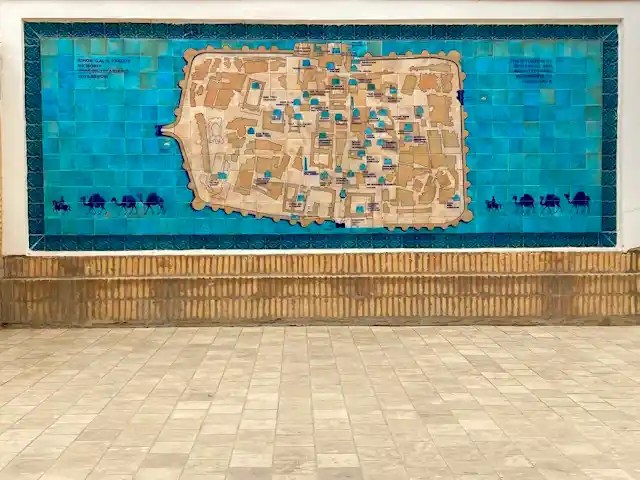
Toki Zargaron (Jewelry Bazaar): Toki Zargaron, the Jewelry Bazaar of Khiva, is a fascinating place within the historic walls of Ichan Qala. Dating back to the 19th century, it served as the bustling marketplace where artisans and traders showcased their finest jewelry and precious gems. The bazaar’s architecture, adorned with ornate tilework and intricate carvings, reflects the opulence and sophistication of the era.
Visitors can explore the narrow alleyways lined with stalls offering a dazzling array of traditional Uzbek jewelry, including intricately crafted rings, necklaces, and bracelets. Today, Toki Zargaron remains a lively cultural hub, preserving Khiva’s rich legacy of craftsmanship and trade. It’s a great place to experience local culture and pick up some unique treasures.

